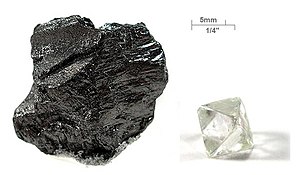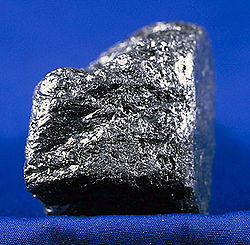Chemicals/Carbons
Emissions
[edit | edit source]
Carbon has an emission line in plasmas at 529.053 nm from C VI.[1]
"The [oxygen] green line occurs at 5577.339Å, in the middle of the strong C2 (1,2) band, and thus has seldom been observed."[2]
Carbon has one strong line in the red.
Carbon has three emission lines that occur in an electron cyclotron resonance (ECR) heated plasmas: 464.742, 465.025, and 465.147 nm from C III.[1]
Carbon has an emission line that occurs in plasmas at 449.881 nm from C VI.[1]
From the spectrum above, carbon has at least two lines in the violet.
Solids
[edit | edit source]
Carbonides
[edit | edit source]Carbonides are naturally occurring minerals composed of 50 atomic percent, or more, carbon. Carbonide-like minerals with greater than 25 at % carbon are also included. This separates carbon containing minerals from carbonates which are at most 25 at % carbon.
Def. any
- "binary compound of carbon and a more electropositive element",[3]
- the "polyatomic ion C2−
2, or any of its salts",[4] - the "monatomic ion C4−
, or any of its salts",[4] - a "carbon-containing alloy or doping of a metal or semiconductor, such as steel",[4]
- an "archaic form of carbide",[5] or a theoretical definition:
- "naturally occurring compounds composed of 50 atomic percent, or more, carbon"[6]
are called carbonides.
The second part of a theoretical definition:
Def. "naturally occurring compounds with greater than 25 at % carbon but less than 50 at % carbon"[7] are called carbonide-likes.
Anthracites
[edit | edit source]
Def. a "form of carbonized ancient plants; the hardest and cleanest-burning of all the coals; hard coal"[8] is called anthracite.
Def. a coal of a hard variety that contains relatively pure carbon is called an anthracite.
Chaoites
[edit | edit source]Chaoites are another hexagonal form of native carbon. It occurs as "thin lamellae (3-15 microns wide), alternating with graphite and perpendicular to the {0001} face of graphite."[9]
"Occurs in association with graphite, zircon, and rutile in shocked graphite gneisses from Mottingen in the Ries Crater, Germany. Also observed from the Goalpara and Dyalpur carbonaceous chondrites."[9]
Coals
[edit | edit source]
Def. a "black rock formed from prehistoric plant remains, composed largely of carbon and burned as a fuel"[10] is called a coal.
Types of coal include: "bituminous, anthracite, or lignite, and grades and varieties thereof."[10]
Coal is mostly carbon with variable amounts of other elements; chiefly hydrogen, sulfur, oxygen, and nitrogen.[11]
Coal is composed of macerals, minerals and water.[12] Fossils and amber may be found in coal.
Diamonds
[edit | edit source]
Def. a "naturally occurring, glimmering glass-like allotrope of carbon in which each atom is surrounded by four others in the form of a tetrahedron"[13] is called a diamond.
Graphites
[edit | edit source]
Graphite is a hexagonal form of carbon that often appears as tabular crystals.
Jets
[edit | edit source]
Def. a "hard, black form of coal"[14], specifically lignite is called a jet.
Lonsdaleites
[edit | edit source]"The mineral Lonsdaleite is a translucent, brownish yellow and is made from the atoms of carbon but the arrangement of these atoms is different from the arrangement of carbon atoms in a diamond. [...] The mineral is very rare and is formed naturally whenever [...] graphite containing meteorites fall on the earth and hit the surface."[15]
"Found in the Canyon Diablo and Goalpara meteorites."[9]
Silicon hydrogenated amorphous carbons
[edit | edit source]"The broad, 60 < FWHM < 100 nm, featureless luminescence band known as extended red emission (ERE) is seen in such diverse dusty astrophysical environments as reflection nebulae17, planetary nebulae3, HII regions (Orion)12, a Nova11, Galactic cirrus14, a dark nebula7, Galaxies8,6 and the diffuse interstellar medium (ISM)4. The band is confined between 540-950 nm, but the wavelength of peak emission varies from environment to environment, even within a given object. ... the wavelength of peak emission is longer and the efficiency of the luminescence is lower, the harder and denser the illuminating radiation field is13. These general characteristics of ERE constrain the photoluminescence (PL) band and efficiency for laboratory analysis of dust analog materials."[16]
"The PL efficiencies measured for [hydrogenated amorphous carbon] HAC and Si-HAC alloys are consistent with dust estimates for reflection nebulae and planetary nebulae, but exhibit substantial photoluminescence below 540 nm which is not observed in astrophysical environments."[16]
"Optical constants measured at normal incidence for iron (Bolotin et al., 1969) and for iron-nickel alloys (Sasovskaya and Noskov, 1974) also predict a red-sloped spectrum."[17]
Space carbons
[edit | edit source]Apparently graphitic-like carbon particles such as shown in the image on the right have been found in space and brought back to Earth.
Biochemicals
[edit | edit source]"In general, during 1990-1991 most of the carbon biomass was contributed by diatoms, while during 1992-1993 it was contributed mainly by flagellates, although during Leg II of 1993 dinoflagellates were the dominant group in terms of carbon content."[18]
Resources
[edit | edit source]See also
[edit | edit source]References
[edit | edit source]- ↑ 1.0 1.1 1.2 K. J. McCarthy; A. Baciero; B. Zurro; TJ-II Team (12 June 2000). Impurity Behaviour Studies in the TJ-II Stellarator, In: 27th EPS Conference on Contr. Fusion and Plasma Phys.. 24B. Budapest: ECA. pp. 1244-7. http://crpppc42.epfl.ch/Buda/pdf/p3_116.pdf. Retrieved 20 January 2013.
- ↑ Anita L. Cochran; W. W. Jackson (September 2006). "What is the Parent of Cometary O (1S)?". Bulletin of the American Astronomical Society 38: 516.
- ↑ SemperBlotto (3 January 2006). carbide. San Francisco, California: Wikimedia Foundation, Inc. https://en.wiktionary.org/wiki/carbide. Retrieved 16 May 2022.
- ↑ 4.0 4.1 4.2 Paul G (3 January 2006). carbide. San Francisco, California: Wikimedia Foundation, Inc. https://en.wiktionary.org/wiki/carbide. Retrieved 16 May 2022.
- ↑ Equinox (24 November 2011). carbonide. San Francisco, California: Wikimedia Foundation, Inc. https://en.wiktionary.org/wiki/carbonide. Retrieved 16 May 2022.
- ↑ Marshallsumter (31 July 2015). Minerals/Carbonides. San Francisco, California: Wikimedia Foundation, Inc. https://en.wikiversity.org/wiki/Minerals/Carbonides. Retrieved 16 May 2022.
- ↑ Marshallsumter (29 October 2015). Minerals/Carbonides. San Francisco, California: Wikimedia Foundation, Inc. https://en.wikiversity.org/wiki/Minerals/Carbonides. Retrieved 16 May 2022.
- ↑ "anthracite". San Francisco, California: Wikimedia Foundation, Inc. 30 January 2015. Retrieved 2015-02-09.
- ↑ 9.0 9.1 9.2 Willard Lincoln Roberts; George Robert Rapp Jr.; Julius Weber (1974). Encyclopedia of Minerals. New York, New York, USA: Van Nostrand Reinhold Company. pp. 121-2.
- ↑ 10.0 10.1 "coal". San Francisco, California: Wikimedia Foundation, Inc. 1 January 2015. Retrieved 2015-01-05.
- ↑ Blander, M. "Calculations of the Influence of Additives on Coal Combustion Deposits" (PDF). Argonne National Laboratory. p. 315. Archived from the original (PDF) on 28 May 2010. Retrieved 17 December 2011.
- ↑ "Coal". British Geological Survey. March 2010.
- ↑ diamond. San Francisco, California: Wikimedia Foundation, Inc. October 16, 2012. http://en.wiktionary.org/wiki/diamond. Retrieved 2012-10-23.
- ↑ "jet". San Francisco, California: Wikimedia Foundation, Inc. 15 November 2014. Retrieved 2015-01-10.
- ↑ payam (30 July 2013). Top 10 Hardest Material in the world. Help Tips. http://helptips.net/26/top-10-hardest-material-in-the-world/. Retrieved 2015-07-30.
- ↑ 16.0 16.1 T. L. Smith; A. N. Witt (December 1999). "The Photoluminescence Efficiency of Extended Red Emission as a Constraint for Interstellar Dust". Bulletin of the American Astronomical Society 31: 1479. http://adsabs.harvard.edu/abs/1999AAS...195.7406S. Retrieved 2013-08-02.
- ↑ Daniel T. Britt; Carle M. Pieters; Peter H. Schultz (December 1986). "Source of the optical red-slope in iron-rich meteorites". Meteoritics 21 (12): 340-1. http://adsabs.harvard.edu/full/1986Metic..21..340B. Retrieved 2013-08-02.
- ↑ V. E. Villafañe; E. W. Helbling; O. Holm-Hansen (October 1995). "Spatial and temporal variability of phytoplankton biomass and taxonomic composition around Elephant Island, Antarctica, during the summers of 1990–1993". Marine Biology 123 (4): 677-86. doi:10.1007/BF00349110. http://link.springer.com/article/10.1007/BF00349110. Retrieved 2013-08-29.
